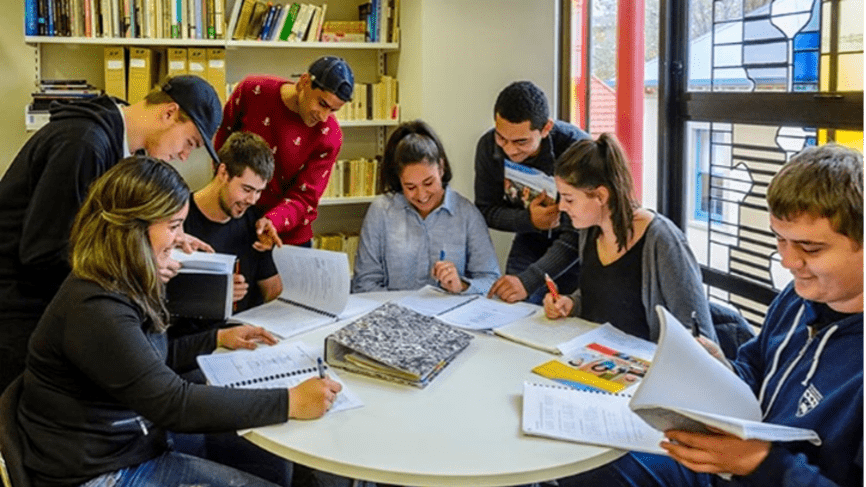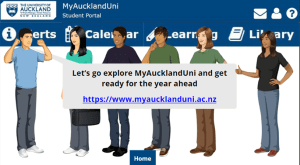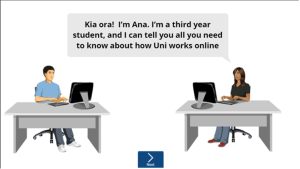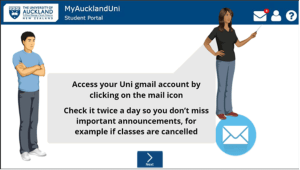Inclusive practices in Canvas online orientation and peer-to-peer support
Using technology to design, produce and implement inclusive online orientation activities for students.
Dr Agnieszka Zabicka shares her approach to accessible and inclusive strategies to welcome students to the Tertiary Foundation Programme (TFP). The online orientation project was designed to reflect the group’s diversity and address the common technological challenges for students from equity backgrounds.

Background
The Tertiary Foundation Certificate (TFC) is designed to create a pathway for entry into the University. It also seeks to ensure that once students have completed their TFC, they will be equipped with the skills necessary to complete their chosen degree.
The TFC programme cohort comprises approximately 200 students from diverse educational, cultural and socio-economic backgrounds, often within and across intersecting equity groups.
Agnieszka identified the need to address common technological challenges faced by students:
Ever since the introduction of Canvas in 2016, I have been aware that the TFC cohort was not altogether conversant with the technology. They needed a lot of guidance to grasp the IT essentials necessary for their academic success. The existing lack of training in online University of Auckland systems for students made it difficult for TFC students to catch up, and this meant that they could miss out on vital information and connections.
The TFC cohort is arguably in more need of online guidance than the general student population because of their diverse socioeconomic background and life experience. A sizable percentage of the cohort hails from equity groups; many new entrants have low computer literacy levels and access to technology. The Online Orientation (OO) plan aimed to foster inclusive learning by addressing this technological gap and making IT essentials accessible to all students.
Design process
The Online Orientation activities were made possible through funding support from a Schuler Educational Enhancement and Development (SEED) grant and help from the Centre for Learning and Research in Higher Education (CLeaR) staff.
Members of the Canvas support team assisted with the design of online activities. Support was also available to deal with practical issues that arose for students while engaging in the activities. Planning the rollout of activities (for example, room bookings and the recruitment of student volunteers) on orientation day required the support of the TFC coordinator, which was provided.
Canvas and MyAucklandUni portal was crucial to the success of the pilot.
Learning activities embedded into the orientation experience includes:
- Students interacting with animated Canvas-based slideshow activity informing new entrants of the essentials of the online University experience (MyAucklandUni portal, University Gmail account, Canvas, Calendars, Libraries and Learning Services, computer labs location etc.).
- Students needing to use their username to log in to systems meant that staff had confidence that they knew what their username and password were.
- Ungraded Canvas Quiz aimed to check the participants’ engagement with the above elements of the online University experience.
- Canvas Assignment (English survey) worth 2.5% of the final grade to engage the students and gather data about their hobbies, literacy levels, work and family commitments etc.
- 20-minute compulsory peer-instructed computer lab session aimed at introducing all new entrants to the OO materials, as well as checking their enrolment status and online literacy (the sessions were led by trained former TFC student volunteers with staff supervision).
- Follow-up check-in with any students who failed to engage in the OO activities.
Any students experiencing difficulty were identified early in the semester, as these activities were delivered during orientation week.
Implementation and evaluation
Gauging online literacy and student capacity to engage with relevant technologies was a clear goal of the programme. Data collection and analysis to evaluate the approach were completed by a research assistant.
What worked well?
Overall, the Academic Resilience Canvas course successfully introduced the TFC students to the basics of online learning, resulting in much higher student engagement with Canvas compared to previous years.
Students benefited from the peer instruction model during the computer lab session with students from the previous year, sharing tips and tricks.
Challenges around students not having or knowing their usernames or passwords which lead to them not being able to log in to the computers during orientation. The OO activities helped to identify and assist students with enrolment issues or Canvas access issues early on. These issues were noted, reported to SSO, and mostly resolved before the beginning of the semester, which was a massive improvement on existing procedures.
In prior years, access issues were frequently unidentified until the second week of the semester resulting in students being unable to access learning materials and subsequently falling behind in coursework.
The associated quiz and trigger assignment activities act as predictive tools indicating student engagement in the TFC programme – of the unsuccessful students (discontinued or failing), 60% did not fill in the voluntary quiz as compared to 28.5% of the successful A-range students. This result can be used for an early intervention – contacting the students who didn’t fill in the quiz early in Week 1 to discuss their engagement with the course. The trigger assignment survey provides a wealth of data on student interests, literacy levels, and other commitments, which can help identify at-risk groups for targeted support.
Implementation
Reflection
Lessons learnt
- New students benefit from guidance and training on IT essentials as they are less computer-savvy than they are made out to be. This is true, especially for students from equity groups (most of the TFC cohort). Trying to absorb the information required to navigate online University systems such as Canvas without targeted, in-person guidance can be confusing and alienating.
- Students need accessible, easy-to-follow guides to online University systems. Still, the in-person peer instruction we provided made a difference in the level of student engagement and understanding. It is not enough to put out online guides, which often go unnoticed. Relatable peer instruction is crucial in relaying the relevant information to new entrants without overwhelming them or appearing to condescend to them.
- Engagement with Canvas and other IT essentials is directly connected to student success. This engagement can be measured early on using easy Canvas-based tasks and trigger assignments to check students’ motivation and engagement with the course.
What would you do differently?
The TFC orientation activities will continue to be delivered within Canvas. The activities will look similar to the original iteration. However, some critical learnings will be taken into account:
- An early effort will be given to the organisation of groups for the lab session – this includes training for the volunteers, so they know what they will be required to do on the day.
- The computer lab sessions were somewhat chaotic, with some new entrants having difficulties finding their assigned lab and engaging with the student helpers. Multiple new entrants did not have their usernames and passwords ready, leading to issues logging on to the computers.
- Some of the student helpers were more prepared and confident with the peer-to-peer learning model than others, resulting in an uneven level of engagement between the lab groups.
- Back-up technical support will be available to iron out access issues as soon as they are identified. A few of the labs had minor technical issues with computer access, which were compounded by a lack of technical support on site (the TFC Orientation took place on a Saturday when technical IT support is unavailable).
- The OO activities will be altered to be more dynamic and interactive for the students. It will be redesigned to make them more accessible and relatable for the new cohort.
The OO was developed to support students beginning their TFC. These activities could be valuable for all first-year students coming into university to ensure that everyone starts the semester with the same essential online competencies.
Further resources
This case study was adapted from telod.ac.nz.
Related readings:
- Kift, S., Nelson, K., & Clarke, J. (2010). Transition pedagogy: a third generation approach to FYE–a case study of policy and practice for the higher education sector. The International Journal of the First Year in Higher Education, 1(1), 1+. https://link.gale.com/apps/doc/A243278083/AONE?u=learn&sid=bookmark-AONE&xid=4c3c85ed
- Perera, V., Moriña, A., Sánchez-Díaz, N., & Spinola-Elias, Y. (2021). Technological platforms for inclusive practice at university: A qualitative analysis from the perspective of spanish faculty members. Sustainability, 13(9), 4755. https://www.mdpi.com/2071-1050/13/9/4755
- Neal Dreamson, Gary Thomas, Anita Lee Hong & Soyoung Kim (2017) Policies on and practices of cultural inclusivity in learning management systems: perspectives of Indigenous holistic pedagogies, Higher Education Research & Development, 36:5, 947-961, DOI: 10.1080/07294360.2016.1263830







